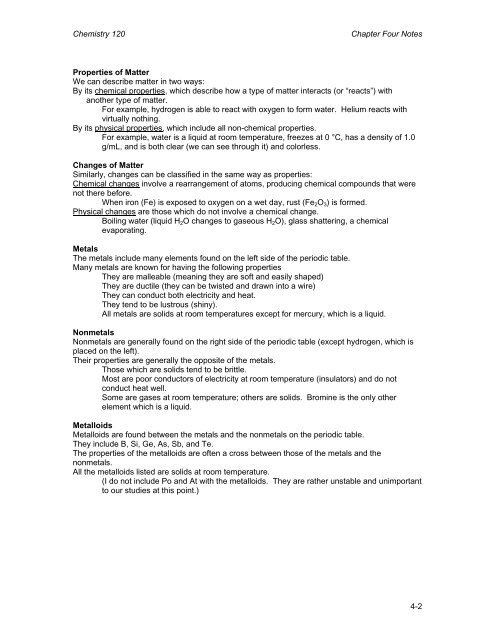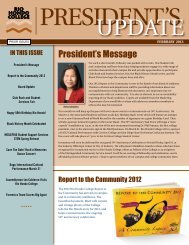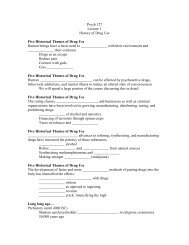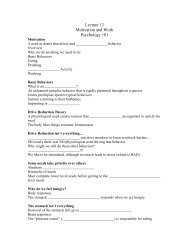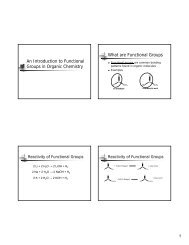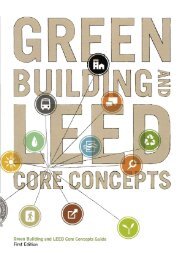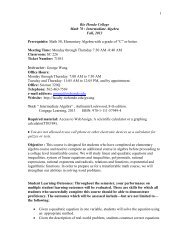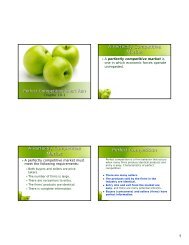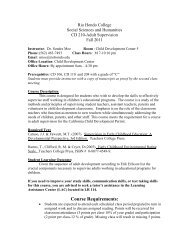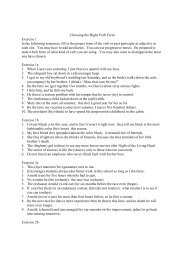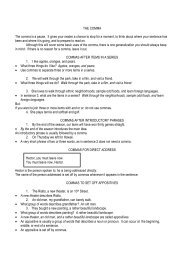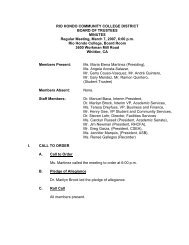You also want an ePaper? Increase the reach of your titles
YUMPU automatically turns print PDFs into web optimized ePapers that Google loves.
<strong>Chemistry</strong> <strong>120</strong><br />
Chapter Four <strong>Notes</strong><br />
Properties of Matter<br />
We can describe matter in two ways:<br />
By its chemical properties, which describe how a type of matter interacts (or “reacts”) with<br />
another type of matter.<br />
For example, hydrogen is able to react with oxygen to form water. Helium reacts with<br />
virtually nothing.<br />
By its physical properties, which include all non-chemical properties.<br />
For example, water is a liquid at room temperature, freezes at 0 °C, has a density of 1.0<br />
g/mL, and is both clear (we can see through it) and colorless.<br />
Changes of Matter<br />
Similarly, changes can be classified in the same way as properties:<br />
Chemical changes involve a rearrangement of atoms, producing chemical compounds that were<br />
not there before.<br />
When iron (Fe) is exposed to oxygen on a wet day, rust (Fe 2 O 3 ) is formed.<br />
Physical changes are those which do not involve a chemical change.<br />
Boiling water (liquid H 2 O changes to gaseous H 2 O), glass shattering, a chemical<br />
evaporating.<br />
Metals<br />
The metals include many elements found on the left side of the periodic table.<br />
Many metals are known for having the following properties<br />
They are malleable (meaning they are soft and easily shaped)<br />
They are ductile (they can be twisted and drawn into a wire)<br />
They can conduct both electricity and heat.<br />
They tend to be lustrous (shiny).<br />
All metals are solids at room temperatures except for mercury, which is a liquid.<br />
Nonmetals<br />
Nonmetals are generally found on the right side of the periodic table (except hydrogen, which is<br />
placed on the left).<br />
Their properties are generally the opposite of the metals.<br />
Those which are solids tend to be brittle.<br />
Most are poor conductors of electricity at room temperature (insulators) and do not<br />
conduct heat well.<br />
Some are gases at room temperature; others are solids. Bromine is the only other<br />
element which is a liquid.<br />
Metalloids<br />
Metalloids are found between the metals and the nonmetals on the periodic table.<br />
They include B, Si, Ge, As, Sb, and Te.<br />
The properties of the metalloids are often a cross between those of the metals and the<br />
nonmetals.<br />
All the metalloids listed are solids at room temperature.<br />
(I do not include Po and At with the metalloids. They are rather unstable and unimportant<br />
to our studies at this point.)<br />
4-2


